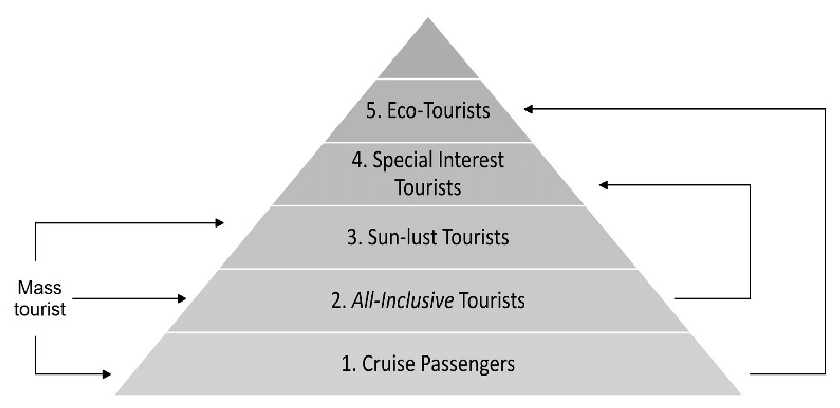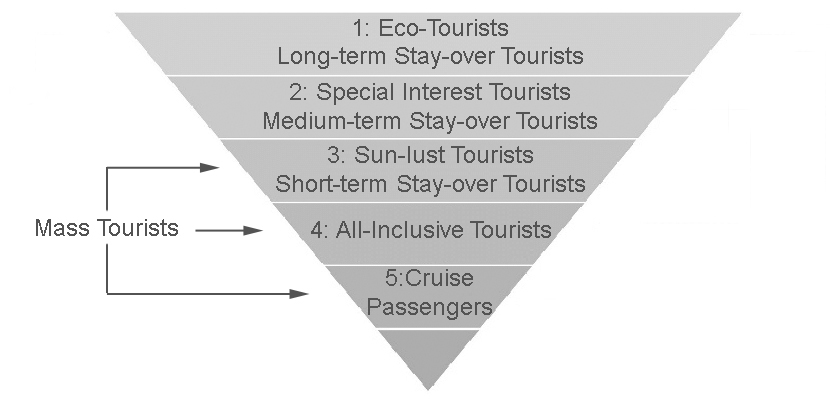
What is Tourism Truth?
Albert Einstein said, "We have to learn to think in a new way."*

Albert Einstein said, "We have to learn to think in a new way."*
What is really going on in the tourism sector? Its complicated.
The economic value of tourists is quite high and therefore much sought after and fought over by tour companies and destinations.
It comes down to this: In destinations where environment, infrastructure and social structures are easily overwhelmed or compromised by too many tourists:
More, clearly, is not better. Avoiding overtourism and returning to first principles in an endemic COVID era. 'Careful what you wish for'.
Low value, short stay, high impact budget tourism is not the way forward, especially for destinations at risk. Destinations at risk must find ways to reduce arrival numbers, and associated costs, while increasing visitor spend in-destination (aka revenue or foreign exchange) that is not leaked back to outside entities. For many destinations, this may not be as difficult or disruptive as it sounds.
Also, the way to understand the selling mechanism is this: The entity that owns [ the product ], or the rights to it, should be the one who decides who sells [ the product ] and how [ the product ] is to be sold into the marketplace. The entity that owns [ the product ] should be the one who stands to profit most by selling it.
Thirty ways to explore the future of tourism: (Starting points for further study)
|
Overtourism is characteristic of the late 'Consolidation' to early 'Stagnation' phases of The Tourism Area Life Cycle (TALC) Model by Richard Butler. Destinations, and their residents, are being punished for their success.
Many destinations are blind-sided and overwhelmed by the numbers of tourists that arrive. The real power to determine who should visit, and so on, should be held in the destination where the people and resources that make tourism attractive actually reside. Foreign tour companies did not pay for any of this yet they profit handsomely from these resources. Placing the power to decide in the destination as opposed to the tour companies may be unpopular with a small number of CEOs but it will be very popular with a large number of residents (read: potential workers) in the destinations. Ultimately, this becomes a balancing act between selling tours and destinations ability to take them in. The goal is for the betterment of destinations, the protection of resources and for longer term benefits to the local people.
The "Bin dere, Dun dat" syndrome: A typical conversation might go like: "So, last week we went to "San Gimignano. Have you been there?" "Where? Oh, ... Tuscany, its a bit of a blur, we stayed there last year, overnighted in an airbnb and went to eat at really nice little cafe, it was marvellous ... and then I think we went to Barcelona". Then, someone posts a glowing review on a big review site and suddenly a massive herd of visitors descends on the place. The film "If it's Tuesday, this must be Belgium!" revealed this type of tourism over 50 years ago but it still seems to be very popular, if not the least for its apparent brand of "jet-set" glamour. Now people take a bunch of selfies with their "smart phones" and often don't even remember anything about the place. Unlikely that anyone was truly 'moved' by this low-value but high impact exploitative practice?
Is Caribbean tourism in overdrive? Investigating the antecedents and effects of overtourism in sovereign and nonsovereign small island tourism economies (SITEs) Authors: Ryan Peterson, Central Bank of Aruba, Oranjestad, Aruba, and Robin B. DiPietro, School of Hotel, Restaurant and Tourism Management, U South Carolina; International Hospitality Review, 2021
Study results confirm the negative impacts of over-tourism in most Caribbean countries. Stagnating economic growth, labour force participation and wage rates, workforce development and specifically perceived unequal wealth distribution all point to an urgent need to modernize economic policies so as to avoid further degradation. Local governments need to act now to end the practice of development agendas and policies being set by external entities. A collaborative mindset between local stakeholders is urgently needed. Tourism planning needs to be based on a longer term view as opposed to the current short term thinking.
See also: Over the Caribbean Top: Community Well-Being and Over-Tourism in Small Island Tourism Economies by Ryan R. Peterson, International Journal of Community Well-Being (05 November 2020)
Who is advocating for improvements to a commerce system that is off the rails? Who is at the front of the line to fix these problems? And are they having enough positive impact to make a difference? Let's hope so. There is much to be learned from these 'Thought Leaders in Responsible and Sustainable Tourism'.
Negative impacts exist everywhere tourism exists. These impacts become more severe in poorer / smaller nations where the resources are more sensitive to over-use and the ability to adapt / recover is hampered by the lower incomes and smaller tax bases. In effect, it is a vicious cycle and a persistent form of colonial exploitation. The large conglomerates don't want this to end because, then there would be nowhere to exploit. At the same time, residents in destinations know best what they want to protect and need to be left alone to decide exactly how to do that.
Arrival data are nearly useless and should not be used as the only benchmark. There is no breakdown of the type of visitor and little information about their stay. Destinations need to segment between different types of visitors in order to target more valuable visitors. Is the statistical coverage improving?
On the one hand: Big conglomerates sell into poorer / smaller nations such as island destinations but keep the bulk of the profits for themselves:
On the other hand: Destinations must safeguard the very elements that made them attractive in the first place: Inverting the pyramid**.
Frankly, who cares about visitors when the most noticeable result is damage. Damage that is often permanent and beyond the capacity of the destination to recover from. It is almost impossible to recover once a site has lost its appeal.
The visitors come and go but the resident hosts must stay in their 'places' to endure the hangover from the visitors, pay for expensive infrastructure and clean up after the visitors have gone. Even worse, the biosphere and local attributes that attracted visitors in the first place are seriously compromised and may never return to their former splendour. As a result, the big conglomerates sell into to some other exotic location and the pattern repeats. Again, potential visitors are blithely unaware.
Now, smaller destinations are more and more realising: Hosting tourism at scale is becoming very expensive and the visitor tap can be shut off at any time with no warning. As well, newly elected politicians with little training are often pitching against big conglomerates who have teams of people skilled in negotiating, and lots of money. The combination is clearly precarious. Destinations could strengthen their position by negotiating collectively, but will they?
Visitor segmentation: Understanding more about why visitors visit and how to attract higher dollar visitors
Length of stay
Other considerations
Tourism promoters and destination managers know how to do all of these things, so why don't they? The answer is they put their bottom line —mostly short term profit first. They do not include any charge for social or environmental costs in their cost of doing business. Clearly it is this practice that needs to be under review. Before it is too late, tourism suppliers and destination managers are duty-bound to make certain that local people and resources are protected in order to provide longer term benefits to residents and attractiveness to potential visitors.
The problem is, that for any of these policies to be effective, they need to be implemented and coordinated by a number of countries collectively. Doubtful that this could happen but, then again, 136 countries agreed on a 15% minimum corporate tax in 2021, so it can happen. A BIG thank you to Janet Yellen, and others.
But, how do you actually do this?
The marketing of longer as opposed to shorter stays would be accomplished by incentivising longer stays and de-incentivising shorter stays. The mechanism could be implemented by DMOs to the tour companies as well as directly to visitors.
Also, if destinations want to increase their marketing power and take it away from the big tour operators, hire their managers and marketing experts.
None of this is new but ultimately, the quest is to get past the hyperbole to understand what actually is 'tourism truth'. And to use this knowledge to move forward in ways that are more beneficial to local people and biodiversity.
** Inverting the pyramid: In 2002, Chandana Jayawardena spoke about a visitor "pyramid of tourism segmentation" with eco-tourists in the top tier, representing the smallest but most valuable segment:

source: Jayawardena, 2002; Mastering Caribbean Tourism, International Journal of Contemporary Hospitality Management, 14/2, pp 88-93.
Long and medium-term stay-over visitors and Eco-tourists are seen as the most valuable in terms of economic contribution. So, for example, by inverting this pyramid, these visitors would become the larger groups and therefore have a greater potential to contribute to local economies, both collectively as well as per person. This is where tourism promotion efforts must be directed. Since mass tourism contributes a lower proportion of revenue/person, this type of tourism becomes de-emphasized. For both All-inclusive and Cruise passengers the contribution to local economies is very small/negligible. The middle group, Sun-lust tourists, should be encouraged to stay-over longer by lowering visitor taxes and other incentives on a minimum stay of 8-10 days.

With this in mind, it needs to be destination authorities/managers, and not tour companies, who decide which type of visitor they want to bring in. The resources belong to the residents in the destination. With nice cool, shady places under those trees they planted, they will be better positioned to contemplate how these resources are to be used.
* The quote from Albert Einstein, "We have to learn to think in a new way", has been co-opted in ways such as, "The problem cannot be solved by using the same thinking that created it in the first place". Any way we see it, the problem is that we must learn from the past in order not to repeat it. It is important that Einstein said "learn to think" and not simply "think", emphasizing there is a way to think that is already outdated and so we must learn again. Einstein also said in 1955, "All, equally, are in peril, and, if the peril is understood, there is hope that they may collectively avert it", with respect to the use of nuclear weapons. Human thinking, therefore, contains both the seeds of our own destruction as well as the way to save ourselves from it. See, for example: Einstein Enigmatic Quote and The Russell-Einstein Manifesto.